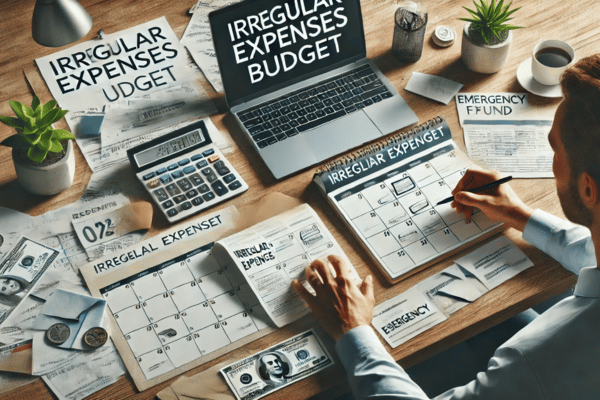Budgeting is a powerful tool for gaining control over your finances — but what happens when your expenses are anything but predictable? Irregular expenses, like annual insurance premiums, holiday shopping, car repairs, or medical bills, can throw even the most well-organized budget off track. The key to staying in control is not avoiding these costs, but planning for them in a smart and proactive way.
In this article, we’ll walk through how to identify irregular expenses, how to prepare for them, and how to build a flexible budget that works even when your spending isn’t consistent month to month.
What Are Irregular Expenses?
Irregular expenses are costs that don’t occur monthly but still happen with enough frequency or importance that you should plan for them. They can be either:
- Predictable but infrequent: Things like annual subscriptions, semi-annual car insurance, back-to-school shopping, holiday gifts, or property taxes.
- Unexpected but likely: Car maintenance, home repairs, medical emergencies, or last-minute travel.
These aren’t surprises — they’re part of life. The problem is that many people treat them as emergencies because they don’t show up every month. But with a little planning, you can treat them like any other budget category.
Step 1: Identify All Potential Irregular Expenses
The first step is awareness. Look back over your past 12 months of bank and credit card statements. Make a list of all expenses that:
- Happened only once or twice in the year
- Fell outside your normal monthly bills
- Still had a significant financial impact
Common irregular expenses to consider include:
- Car repairs and maintenance (oil changes, new tires)
- Medical bills and dental visits
- Annual memberships or subscriptions
- Holiday gifts and celebrations
- Travel or vacations
- Back-to-school costs
- Pet care and vet visits
- Home maintenance and repairs
- Insurance premiums (paid quarterly or annually)
Once you have a list, add up the total you spent on each category over the last year. This gives you a realistic view of how much you need to budget going forward.
Step 2: Break Down the Annual Cost into Monthly Amounts
Now that you know what these expenses cost you annually, divide each total by 12 to determine how much you need to set aside each month. This strategy is called a “sinking fund.” It allows you to slowly build up cash for irregular expenses throughout the year so you’re ready when the bill arrives.
Example:
- Car maintenance: $600 per year → $50/month
- Holiday gifts: $900 per year → $75/month
- Insurance premium: $1,200 per year → $100/month
In your monthly budget, these amounts become regular line items — even though you won’t spend them every month. You can keep this money in a separate savings account or track it using a spreadsheet or envelope system to ensure it’s not accidentally spent on something else.
Step 3: Adjust Your Budget to Make Room
It might be challenging at first to add new categories to your monthly budget. But if you’ve ever struggled to pay for a large expense out of one paycheck, this method will feel like a huge relief. Start by reviewing your current discretionary spending and look for areas where you can cut back temporarily — such as eating out, entertainment, or subscriptions — to fund your sinking funds.
If your budget is already tight, start small. Even putting away $10 or $20 per category per month is better than being completely unprepared when an expense hits.
Step 4: Prepare for Truly Unexpected Costs
In addition to sinking funds for known irregular expenses, you should also maintain a general emergency fund. This is money set aside specifically for unpredictable costs that don’t fall neatly into a category, such as medical emergencies, urgent repairs, or a job loss.
Experts recommend building an emergency fund of at least $1,000 to start, and eventually working up to three to six months of living expenses. This gives you a financial cushion to handle life’s surprises without going into debt.
Step 5: Review and Adjust Regularly
Your budget isn’t a one-time project — it’s a living document. Set a reminder to review your budget and your sinking fund categories once a month. Ask yourself:
- Are there any irregular expenses coming up?
- Have you been saving enough in each category?
- Do you need to add or remove a sinking fund?
As your lifestyle and financial needs change, so should your budget. A new car may require more maintenance savings. A canceled subscription may free up funds for another category. Stay flexible and proactive.
Tips to Stay Consistent with Irregular Expense Planning
- Automate savings: Set up automatic transfers to savings accounts dedicated to your sinking funds.
- Use a budgeting app: Many apps allow you to create custom categories and track sinking funds easily.
- Label your savings: Naming your accounts (e.g., “Car Repairs,” “Gifts,” “Insurance”) keeps you motivated and organized.
- Keep it realistic: Don’t try to save too much too fast. Consistency is more important than size in the beginning.
Final Thoughts: Plan Ahead, Stress Less
Irregular expenses don’t have to ruin your financial progress or derail your budget. When you recognize them as predictable parts of life and prepare accordingly, you take control of your money — instead of letting it control you.
By setting up sinking funds, tracking your expenses, and staying flexible, you’ll be able to navigate financial ups and downs with confidence and build lasting financial stability. Budgeting isn’t about being perfect — it’s about being prepared.
